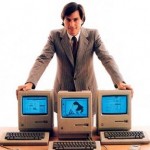October 12, 1988: Steve Jobs Introduces NeXT Computer
Subscribe! Spotify | RSS | More
1988– Davies Symphony Hall in San Francisco, California. Steve Jobs shows off the NeXT Computer featuring the Motorola 68030 microprocessor at 25 MHz. The computer introduces several new features including optical storage disk, voice recognition, and object-oriented languages. The system came with the NeXT STep operating system and cost $6,500.
NeXT computer sold around 50,000 units. The NeXTSTEP Operating System was highly influential. It was the basis of Mac OS X. Apple acquired NeXT on Decemeber 20th, 1996 for $429 million in cash. Steve Jobs became interim CEO of Apple and the rest was history.
Steve Jobs almost didn’t come back after he was fired from Apple. He ended up not only founding NeXT, but also helped with Pixar. It does beg the question: Would we have an iPhone, iPad if Jobs wouldn’t have come back? Same question if he wasn’t brought back as CEO of Apple? Would it have been the NeXTPhone and NeXTPad?
Subscribe to Day In Tech History:
RSS Feed - iTunes - Android - Spotify - iHeartRadio
Facebook -
- RSS Bandwidth by Cachefly Get a 14 Day Trial
- Join me on Patreon and support Day in Tech History
- AMD signs agreement with Intel
- 5th Gen iPod released
- Clockwise or Counterclockwise Silhouette.










![HP41c[1] HP41c[1]](https://dayintechhistory.com/wp-content/uploads/2012/10/HP41c1-340x250.jpg)

![Mad-Men[1] Mad Men](https://dayintechhistory.com/wp-content/uploads/2013/08/Mad-Men1-340x250.jpg)



![virusscan[1] Virus](https://dayintechhistory.com/wp-content/uploads/2013/08/virusscan1-340x250.jpg)


